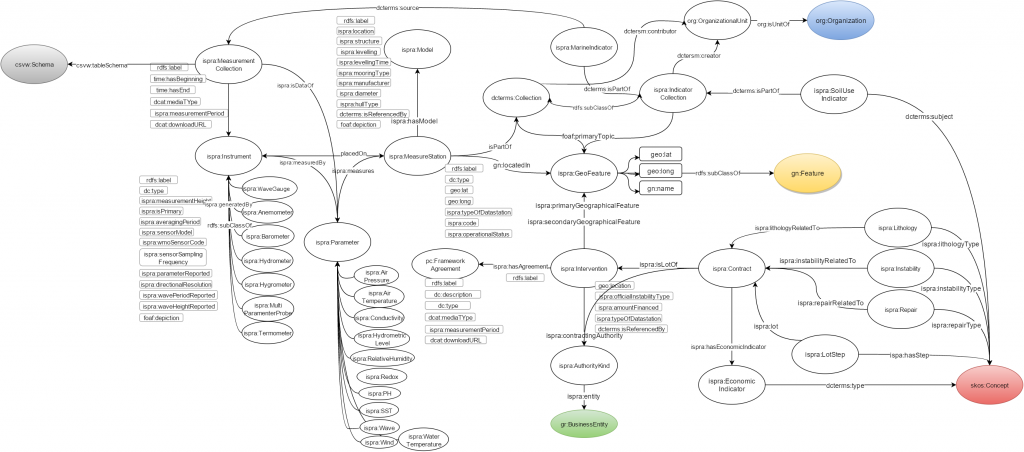The ISPRA ontology network is organised in ontology modules that allow the representation of different concepts contained in environmental data: monitoring stations, observations, indicators, as well as geographical and administrative features associated with environmental information.
ispra-top Ontology
The TOP module defines the highest level concepts and properties that are then specialised in the modules below. For example, the ontology defines classes such as Concept, Collection, and Location that are very general, but at the same time provide supporting concepts for the definition of more detailed classes in the other modules. The namespace of the TOP module is:
https://w3id.org/italia/env/onto/top/
View ispra-top reference document
ispra-plc Ontology
The PLACE module extends the TOP module by adding classes and properties that describe locations in more detail both physically and in their administrative sense. Accordingly, these classes are modelled as subclasses of ispra-top:Location through the use of the axiom rdfs:subClassOf. Similarly, the TOP module is extended by modelling a whole series of properties (e.g. :hasAdministrativeUnit, :hasCountry, etc.) as subproperties of the object property ispra-top:hasLocation through the use of the axiom rdfs:subPropertyOf. The namespace of the PLACE module is:
https://w3id.org/italia/env/onto/place/
View ispra-plc reference document
ispra-emf Ontology
The INSPIRE-MF module models the classes and properties representing the INSPIRE data model relevant for the ISPRA data domain currently represented according to the Linked Data paradigm. In particular, the ontology module represents object instances of the MonitoringObject class in the different possible alternatives, such as MonitoringFacility and MonitoringNetwork. The module also presents classes and properties describing observations, collections of observations, sensors, platforms, networks, observation parameters, procedures, values, etc. The module is inspired by the SSN and SOSA ontologies (extending them in certain cases, e.g. if one wishes to use observation series – ObservationSeries class) and the Internet of Things (IoT) ontology of OntoPiA. Classes and properties are also modelled to represent indicators and collections of indicators. The temporal and geographical characterisation of the indicator is left to the indicator collection. This solution was adopted in order to contain in the final dataset the number of RDF triples concerning the temporal and geographical characterisation of the indicators by using the collection as a grouping for indicators that were obtained in the same place and at the same time. The INSPIRE-MF module directly imports the TOP module. The namespace of the INSPIRE-MF module is:
https://w3id.org/italia/env/onto/inspire-mf/
View ispra-emf reference document
ispra-ren Ontology
The ISPRA ontology network has been extended with the RENDIS ontology module that models knowledge concerning the Repertory of Mitigation Measures for National Soil Protection. The namespace of the RENDIS module is:
https://w3id.org/italia/env/onto/rendis/
View ispra-ren reference document
ispra-core Ontology
The previous ontology (ispra-core) was the result of a close collaboration between domain experts and regesta’s data architects and over time has been subject to changes and additions (ispra-network), especially when publications of new datasets and updates are needed.
The direct reuse of ontologies already existing and widespread internationally was preferred in order to describe the most common and generic metadata while for specific classes and properties of the dataset domain new broadly documented resources were created.
Ontologies and vocabularies reused:
- Foaf ontology
- Dublin Core
- Geonames
- Schema.org
- Organization ontology
- CSVW Namespace Vocabulary Terms
- Quantities, Units, Dimensions and Data Types Ontologies
- SKOS
View ispra-core reference document
